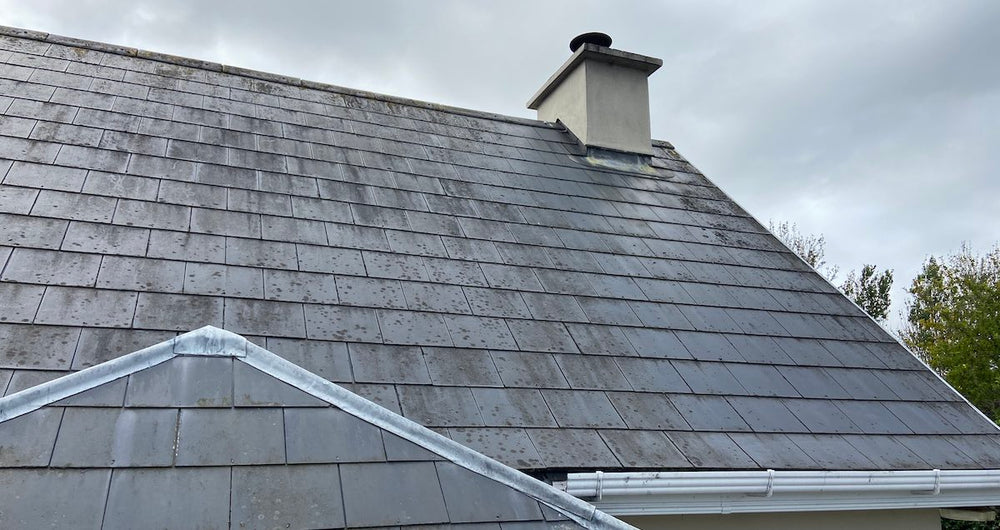
The unsightly red, green, or black staining on a roof is likely due to the presence of algae, lichen, fungi, moss, or mould, or a combination of them all.
Lichen are the round white, brown, and black spots that power washing cannot remove. You’ll probably have noticed lichen on slate and concrete tiled roofs.
Lichen attach themselves to, the surfaces of roofs. The only way to remove lichen is to kill it and wait for the growth to release itself from the surface. This can take anywhere from a few weeks to several months depending on the degree of colonisation and the local environment. A second application of Benz Bio Cleanze after one month will speed up the process.
Moss on roofs often grows in the joints between tiles. This allows water to penetrate where tiles overlap, damaging the underlying timber. Even small amounts of moss can impede the full drainage capacity of a roof.
Moss will normally start to appear around a property after 2-7 years. It particularly loves to grow on concrete roof tiles. On many buildings moss will start to grow on the roof, spread from the roof to the gutters, and then onto footpaths and drives. And moss can spread very quickly.
Moss holds water, which can add weight to a roof causing stress on the structure. It expands when frozen, which can damage tiles and gutters. Keeping a roof clear of moss helps protects a property from the destructive effects of uncontrolled moss growth.
Preparing a roof for soft washing
First remove the moss and other growths by manual scraping. This is important because many roofs only get cleaned when the moss build-up has become extreme. If the pitch of the roof is not too steep, and the tiles are sound, a trained roofer can do this.
If the roof is too steep or fragile to walk on, carry out scraping and spraying work from the ground using tools based on water fed pole technology.
Protect gutter outlets from becoming blocked before beginning work. A tennis ball often works well to block downpipes. And lay tarpaulin around the perimeter of the property to catch any falling moss and other debris.
Protecting plants
Run-off and overspray from Bio Cleanze and Benz Lightning Cleanze can discolour leaves and flowers. Thorough drenching, immediately before and after treating the roof, with copious amounts of fresh water is an effective way to protect your customer's plant life from overspray.
Cllck here to learn more about how to protect your customer's plant life when soft washing
Solar panels
It’s best to treat a roof before fitting solar energy panels – with a strong dilution of Bio Cleanze – because afterwards it will be almost impossible to remove any growths living under the panels.
Can a moss and lichen covered roof be treated with Benz Bio Cleanze alone?
Bio Cleanze is designed to treat the biofilm on a roof, not the moss itself. Moss must first be manually removed by scraping with Benz professional quality roof moss scrapers.
We suggest treating the biofilm twice at 20-30:1. This will enable the Bio Cleanze to soak more deeply into the surface and biofilm, ensuring greater effectiveness.
How long Bio Cleanze will take to fully show results depends on the local environment, prevailing weather and how steep the roof pitch is, because the steeper the pitch the more effective the "self-cleaning" action, powered by the effects of sun, wind and rain, will be. The natural weathering of sun, wind and rain will gradually remove any remaining dead lichen through time.
The cleaning effect of Bio Cleanze will continue for the next 6-12 months. And if the surface is porous, will provide a degree of ongoing protection against re-colonisation.
Quick tip: You will need to educate your customer in advance as to the long-term, ongoing cleaning effect of Bio Cleanze. This is an unusual property of a cleaning chemical, but your customer will be happy when the situation is fully and clearly explained to them.
Soft washing equipment
A window cleaner’s water-fed poles (WFP) are fine for “brushing in” and avoid the use of ladders for the majority of properties.
Low-pressure application systems use telescopic poles to reach every part of a property. Using these softwash systems means the operator stays on the ground, or on sturdy scaffolding, which is safer both for him and his customer’s property. Using a coarse spray of relatively large droplets will minimise spray drift.
Quick tip: Soft washing roofs with Bio Cleanze is a profitable extra service to the repair and replacement work of existing roofing contractors, who already have the equipment and skills for working at heights.
How long does a softwash treatment last?
Exposure to the sun, nearness of trees, humidity, porosity and quality of the tile’s surface roughness all influence how long it will be before re-treatment becomes necessary.
If the roof has previously been power washed, the porosity and surface characteristics of the tiles will likely have been damaged and so biological growths are likely to return faster. In the worst cases, it may not be possible to clean the tiles completely.
Most roofs will stay clean for three years before biological regrowth requires another treatment. Concrete tiled roofs tend to last longer before regrowth will be visible again and another treatment becomes necessary.
Restoring and cleaning old roofs by soft washing
Some people unknowingly perceive moss, lichen and algae growth on old buildings as a mark of character but in fact such growth can damage the roof structure.
Quick tip: Sandstone may have been used in the construction of walls that support an old roof. If your customer wants you to treat sandstone walls at the same time as the roof, remember that it is soft and needs particular care when being cleaned. Fortunately, using Benz biocide products sandstone can be safely treated without damaging it.
Bio Cleanze acts to gently clean and restore these ancient roofs to their former glory without causing the surface damage that high pressure washing will.
Apply Bio Cleanze evenly across the surface area of the roof. Brushing-in should be done gently and with care. The biofilm will die within a few hours without aggressive action.
Quick tip: If a surface is badly infested with black lichen a treatment with strong solution of Lightning Cleanze prior to treating with Bio Cleanze is often the most effective approach.
Non-aggressive soft washing is the only safe way to clean old slate and tile roofs without damaging the surface of the tiles and therefore reducing their lifespan.
Health & Safety
Before starting work always evaluate the site for Health & Safety considerations and establish safe working methods. Always wear appropriate and effective PPE and wash exposed skin with copious amounts of fresh water before eating, drinking, smoking and upon completion of a job.
We hope this information is helpful and sincerely wish you great success in your soft washing business,
The Benz team



Leave a comment